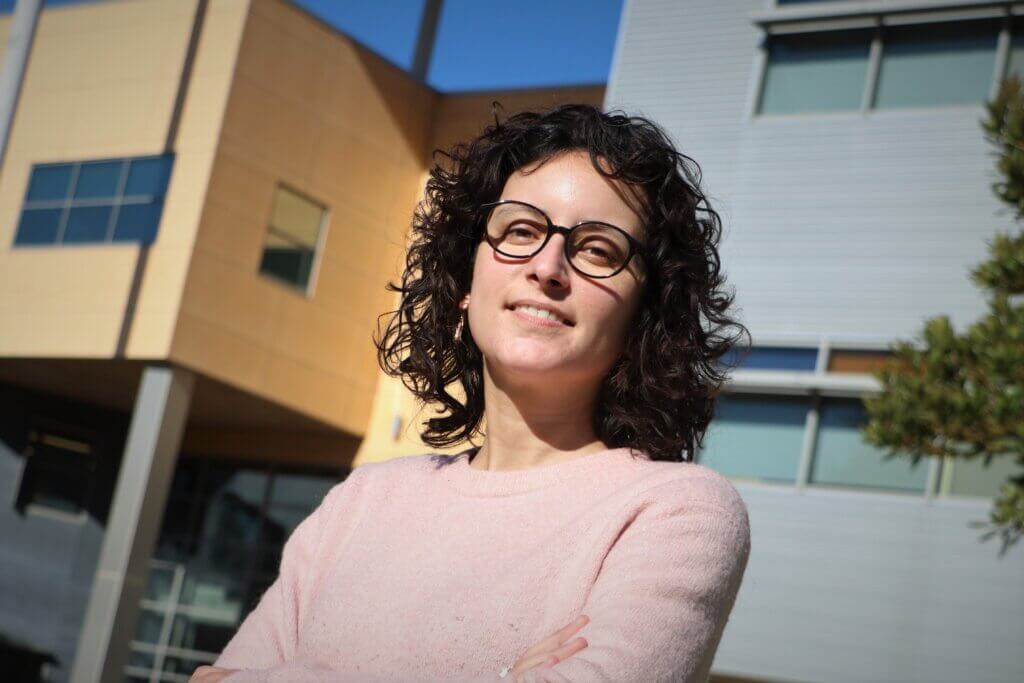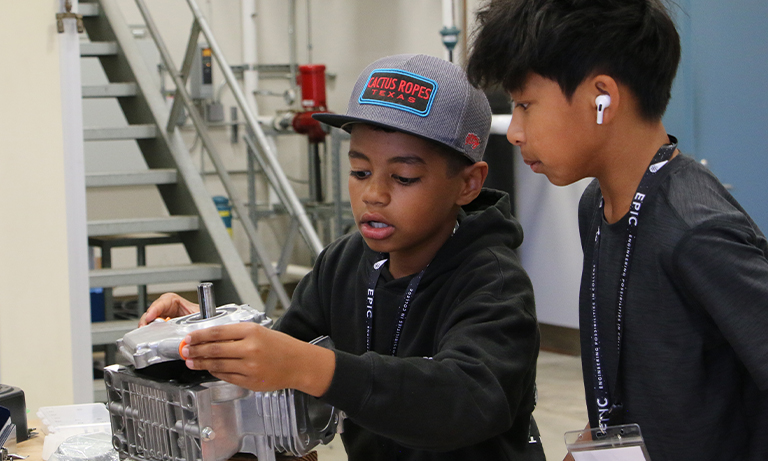At the beginning of John Grimes’ video short, three students lie on the grass in Poly Canyon, gazing at the stars.
“Doesn’t it ever make you wonder what’s going on up there?” one of them wonders aloud. “All the stories and adventures that could be happening?”
Then, a fantasy sequence illustrates some of those possibilities, including an enemy soldier fleeing a laser-shooting spacecraft and a couple of aliens who groove to – why not, really? – Marvin Gaye’s sultry “Let’s Get It On.”
“The idea was that people throughout time have always looked up at the stars and imagined different worlds that are based on the reality of their lives,” Grimes said.

His video, “Other Worlds,” was one of multiple projects posted to an online art exhibition created for Aero 470 – Aerospace Beyond Engineering. The virtual course was created by Assistant Professor Pauline Faure, who wanted students to explore non-engineering aspects of the aerospace industry that are critical to the development and sustainment of aerospace systems.
“I wanted to create a place where students can learn about aerospace much more than the engineering aspect, whether it’s about ethics, the regulatory aspect, or how we even got to where we are right now,” Faure said.
The twice-offered course explored those topics, plus aerospace in media, business, policy and more. Going into class, students were most familiar with aerospace depictions in art. Yet, in aerospace engineering coursework, the industry’s contributions to popular culture are more of a side note.
“As an artist myself, I am often frustrated by the dryness of material and lack of art in the curriculum,” Grimes said. “Art and engineering coexist, and this is a point that is never mentioned in any STEM class I have ever taken.”
After American astronauts landed on the moon in 1969, songwriters like Elton John, the Byrds and Harry Nilsson were inspired to record songs about space, David Bowie practically creating a rock sub-genre with his spacey Ziggy Stardust persona. While early rock songs about space explored the loneliness and isolation of space, movies like the “Star Wars” franchise often portrayed other galaxies as more populated, though often fraught with conflict – an extension of war after an imagined destruction of Earth.
Artists have historically used plenty of artistic license to portray space, Faure said, though collaborations with engineers have provided more realism in recent years.
And in some cases, real astronauts have created art.
Cal Poly graduate Robert “Hoot” Gibson’s gorgeous 1984 photo of fellow astronaut Bruce McCandless during an untethered spacewalk is one of NASA’s most popular images. The technically proficient image doesn’t show McCandless’s face, hidden behind his sun visor, which, McCandless said, allowed people around the world to imagine themselves in the suit. Meanwhile, half the image’s background features the darkness of space contrasted by the bright blue and white earth in the bottom half.
Similarly, when Canadian astronaut Chris Hadfield performed Bowie’s “Space Oddity” at the International Space Station in 2017, the engaging video that accompanied it included shots of Hadfield at a window offering stunning views of the Earth.
“On Earth, we have borders, we see them, we feel them, but when you’re looking to Earth from space, what we see is one humanity, the borders vanish,” Faure said.
Such images, she said, help convey that humanity is united – something international astronaut crews at the ISS have demonstrated.
“Astronauts, regardless of their education — whether they are engineers or scientists or surgeons — they are Earth’s ambassadors,” she said. ”So it’s part of their role to create things to connect to the general public and to communicate what is happening in space in a different manner and to encourage the next generation to be inspired into various STEM fields.”
While students in her class also had the option of creating a business plan or aerospace journal, several embraced the art project, creating drawings, paintings and songs.
Justin Rodriguez wrote and recorded “Galaxy Love,” which paired jazzy chords and relationship lyrics to create a catchy “love song for the galaxy.”
“I wrote this song by brainstorming different words that came to my mind when I thought of ‘space’ and ‘love,’” said Rodriguez, who took the course to learn about influences on aerospace engineering. “After that, I started jamming on my guitar until I found some tune that I liked and applied chords to the tune.”
Creative thinking not only leads to enjoyable art, Faure said – it also helps with STEM work.
“Throughout our education we often learn at school there’s only one solution to the problem – 2 plus 2 equals 4 — and that’s it,” she said.
But often, she added, there is no set solution to a problem, and sometimes there might be more than one solution.
“You have to be creative in how to go about the problem and work together as a multidisciplinary team with different perspectives and ways of thinking. That is the beauty of engineering!”


